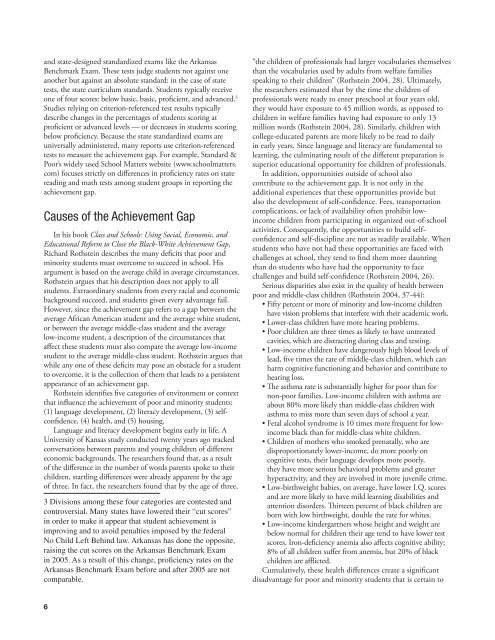WHAT IS ARKANSAS DOING TO CLOSE THE ACHIEVEMENT GAP?
WHAT IS ARKANSAS DOING TO CLOSE THE ACHIEVEMENT GAP?
WHAT IS ARKANSAS DOING TO CLOSE THE ACHIEVEMENT GAP?
You also want an ePaper? Increase the reach of your titles
YUMPU automatically turns print PDFs into web optimized ePapers that Google loves.
and state-designed standardized exams like the Arkansas<br />
Benchmark Exam. These tests judge students not against one<br />
another but against an absolute standard: in the case of state<br />
tests, the state curriculum standards. Students typically receive<br />
one of four scores: below basic, basic, proficient, and advanced. 3<br />
Studies relying on criterion-referenced test results typically<br />
describe changes in the percentages of students scoring at<br />
proficient or advanced levels — or decreases in students scoring<br />
below proficiency. Because the state standardized exams are<br />
universally administered, many reports use criterion-referenced<br />
tests to measure the achievement gap. For example, Standard &<br />
Poor’s widely used School Matters website (www.schoolmatters.<br />
com) focuses strictly on differences in proficiency rates on state<br />
reading and math tests among student groups in reporting the<br />
achievement gap.<br />
Causes of the Achievement Gap<br />
In his book Class and Schools: Using Social, Economic, and<br />
Educational Reform to Close the Black-White Achievement Gap,<br />
Richard Rothstein describes the many deficits that poor and<br />
minority students must overcome to succeed in school. His<br />
argument is based on the average child in average circumstances.<br />
Rothstein argues that his description does not apply to all<br />
students. Extraordinary students from every racial and economic<br />
background succeed, and students given every advantage fail.<br />
However, since the achievement gap refers to a gap between the<br />
average African American student and the average white student,<br />
or between the average middle-class student and the average<br />
low-income student, a description of the circumstances that<br />
affect these students must also compare the average low-income<br />
student to the average middle-class student. Rothstein argues that<br />
while any one of these deficits may pose an obstacle for a student<br />
to overcome, it is the collection of them that leads to a persistent<br />
appearance of an achievement gap.<br />
Rothstein identifies five categories of environment or context<br />
that influence the achievement of poor and minority students:<br />
(1) language development, (2) literacy development, (3) selfconfidence,<br />
(4) health, and (5) housing.<br />
Language and literacy development begins early in life. A<br />
University of Kansas study conducted twenty years ago tracked<br />
conversations between parents and young children of different<br />
economic backgrounds. The researchers found that, as a result<br />
of the difference in the number of words parents spoke to their<br />
children, startling differences were already apparent by the age<br />
of three. In fact, the researchers found that by the age of three,<br />
3 Divisions among these four categories are contested and<br />
controversial. Many states have lowered their “cut scores”<br />
in order to make it appear that student achievement is<br />
improving and to avoid penalties imposed by the federal<br />
No Child Left Behind law. Arkansas has done the opposite,<br />
raising the cut scores on the Arkansas Benchmark Exam<br />
in 2005. As a result of this change, proficiency rates on the<br />
Arkansas Benchmark Exam before and after 2005 are not<br />
comparable.<br />
“the children of professionals had larger vocabularies themselves<br />
than the vocabularies used by adults from welfare families<br />
speaking to their children” (Rothstein 2004, 28). Ultimately,<br />
the researchers estimated that by the time the children of<br />
professionals were ready to enter preschool at four years old,<br />
they would have exposure to 45 million words, as opposed to<br />
children in welfare families having had exposure to only 13<br />
million words (Rothstein 2004, 28). Similarly, children with<br />
college-educated parents are more likely to be read to daily<br />
in early years. Since language and literacy are fundamental to<br />
learning, the culminating result of the different preparation is<br />
superior educational opportunity for children of professionals.<br />
In addition, opportunities outside of school also<br />
contribute to the achievement gap. It is not only in the<br />
additional experiences that these opportunities provide but<br />
also the development of self-confidence. Fees, transportation<br />
complications, or lack of availability often prohibit lowincome<br />
children from participating in organized out-of-school<br />
activities. Consequently, the opportunities to build selfconfidence<br />
and self-discipline are not as readily available. When<br />
students who have not had these opportunities are faced with<br />
challenges at school, they tend to find them more daunting<br />
than do students who have had the opportunity to face<br />
challenges and build self-confidence (Rothstein 2004, 26).<br />
Serious disparities also exist in the quality of health between<br />
poor and middle-class children (Rothstein 2004, 37-44):<br />
• Fifty percent or more of minority and low-income children<br />
have vision problems that interfere with their academic work.<br />
• Lower-class children have more hearing problems.<br />
• Poor children are three times as likely to have untreated<br />
cavities, which are distracting during class and testing.<br />
• Low-income children have dangerously high blood levels of<br />
lead, five times the rate of middle-class children, which can<br />
harm cognitive functioning and behavior and contribute to<br />
hearing loss.<br />
• The asthma rate is substantially higher for poor than for<br />
non-poor families. Low-income children with asthma are<br />
about 80% more likely than middle-class children with<br />
asthma to miss more than seven days of school a year.<br />
• Fetal alcohol syndrome is 10 times more frequent for lowincome<br />
black than for middle-class white children.<br />
• Children of mothers who smoked prenatally, who are<br />
disproportionately lower-income, do more poorly on<br />
cognitive tests, their language develops more poorly,<br />
they have more serious behavioral problems and greater<br />
hyperactivity, and they are involved in more juvenile crime.<br />
• Low-birthweight babies, on average, have lower I.Q. scores<br />
and are more likely to have mild learning disabilities and<br />
attention disorders. Thirteen percent of black children are<br />
born with low birthweight, double the rate for whites.<br />
• Low-income kindergartners whose height and weight are<br />
below normal for children their age tend to have lower test<br />
scores. Iron-deficiency anemia also affects cognitive ability;<br />
8% of all children suffer from anemia, but 20% of black<br />
children are afflicted.<br />
Cumulatively, these health differences create a significant<br />
disadvantage for poor and minority students that is certain to<br />
6






